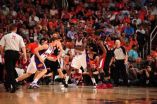(Press-News.org) What makes soccer star Christiano Ronaldo's "knuckleball" shot so unpredictable and difficult to stop? At the American Physical Society's (APS) Division of Fluid Dynamics (DFD) meeting, November 18 – 20, 2012, in San Diego, Calif., a team of researchers investigating this phenomenon will reveal their findings.
A "knuckleball" in soccer refers to a ball kicked at very low spin, which results in a zigzag trajectory. Along its straight path, the ball deviates laterally by roughly the diameter of a ball (0.2 m). The deviation direction appears to be unpredictable, which is extremely frustrating for goalkeepers attempting to block it.
Variations of the knuckleball are also used in baseball and volleyball, so many players and coaches want to understand the physics at play during its zigzag trajectory.
"We decided to study the knuckleball because the physics of sports is such a new field and there are many discoveries to be made," explains Caroline Cohen, a Ph.D. student at École Polytechnique's Hydrodynamics Laboratory (LadHyX) in France.
After trying other experiments, Cohen and colleague Baptiste Darbois Texier, also a Ph.D. student, working with Christophe Clanet, a research director at France's Centre National de la Recherche Scientifique (CNRS), focused on an approach that involves dropping steel beads into a tank of water and studying their trajectory. They discovered that the knuckleball phenomenon occurs, but at much shorter distances. This makes it easier to observe with an ultrafast camera, which lets you see things you can't with the "naked" eye.
"The big surprise is that every bead makes a zigzag – from a little plastic bead to a steel weight of 7 kg (15.4 lbs)," says Cohen. "We wouldn't have bet on this occurring before we tried it, so it was quite exciting to actually see it by doing a simple experiment."
The team demonstrated that – contrary to popular belief – the "knuckle effect" isn't a result of deformations at the site of foot impact or ball seams. What's really going on is that the aerodynamic lift forces that act on a smooth sphere can fluctuate and cause the zigzagging.
At the DFD meeting, Darbois Texier will also describe the significant role the knuckle effect may have played in historic experiments trying to prove the Earth's rotation. "One way to attempt this is to measure the East deviation of a sphere in free fall – from a height of 150 m (492 ft) the deviation is about 3 cm (1.18 in)," he notes. "We found that the results of these experiments were very scattered, and we believe this is because of the lateral deviation caused by the knuckle effect."
The talk, "How Cristiano Ronaldo performs his knuckleball?," is at 8 a.m. on Monday, Nov. 19, in Room 30E.
http://absimage.aps.org/image/DFD12/MWS_DFD12-2012-000981.pdf
###
MORE MEETING INFORMATION
The 65th Annual Meeting of the American Physical Society (APS) Division of Fluid Dynamics will take place from November 18-20, 2012, in San Diego, Calif. It will bring together researchers from across the globe to address some of the most important questions in modern astronomy, engineering, alternative energy, biology, and medicine. All meeting information, including directions to the Convention Center, is at: http://apsdfd2012.ucsd.edu/
USEFUL LINKS
Main Meeting Web Site: http://apsdfd2012.ucsd.edu/
Searchable Abstracts: http://meeting.aps.org/Meeting/DFD12/APS_epitome
Directions and Maps: http://apsdfd2012.ucsd.edu/?page=Venue_and_Maps
PRESS REGISTRATION
Credentialed full-time journalists and professional freelance journalists working on assignment for major publications or media outlets are invited to attend the conference free of charge. If you are a reporter and would like to attend, please contact Charles Blue (dfdmedia@aps.org, 301-209-3091).
SUPPORT DESK FOR REPORTERS
A media-support desk will be available. Press announcements and other news will be available in the Virtual Press Room (see below).
VIRTUAL PRESS ROOM
The APS Division of Fluid Dynamics Virtual Press Room will be launched in mid-November and will feature news releases, graphics, videos, and other information to aid in covering the meeting on site and remotely. See: http://www.aps.org/units/dfd/pressroom/index.cfm
GALLERY OF FLUID MOTION
Every year, the APS Division of Fluid Dynamics hosts posters and videos that show evocative images and graphics from either computational or experimental studies of flow phenomena. The outstanding entries are selected for their artistic content, originality, and ability to convey information. They will be honored during the meeting, placed on display at the 2013 APS March Meeting, and appear in the annual Gallery of Fluid Motion article in the American Institute of Physics' journal, Physics of Fluids.
Selected entries from the Gallery of Fluid Motion will be hosted as part of the Fluid Dynamics Virtual Press Room. In mid-November, when the Virtual Press Room is launched, another announcement will be sent out.
This release was prepared by the American Institute of Physics (AIP) on behalf of the American Physical Society's (APS) Division of Fluid Dynamics (DFD).
ABOUT THE APS DIVISION OF FLUID DYNAMICS
The Division of Fluid Dynamics of the American Physical Society (APS) exists for the advancement and diffusion of knowledge of the Physics of Fluids with special emphasis on the dynamical theories of the liquid, plastic and gaseous states of matter under all conditions of temperature and pressure. See: http://www.aps.org/units/dfd/
What's behind the success of the soccer 'Knuckleball'
2012-11-17
ELSE PRESS RELEASES FROM THIS DATE:
Probing the mystery of the Venus fly trap's botanical bite
2012-11-17
Plants lack muscles, yet in only a tenth of a second, the meat-eating Venus fly trap hydrodynamically snaps its leaves shut to trap an insect meal. This astonishingly rapid display of botanical movement has long fascinated biologists. Commercially, understanding the mechanism of the Venus fly trap's leaf snapping may one day help improve products such as release-on-command coatings and adhesives, electronic circuits, optical lenses, and drug delivery.
Now a team of French physicists from the National Center for Scientific Research (CNRS) and Aix-Marseille University in ...
Exercise benefits found for pregnancies with high blood pressure
2012-11-17
EUGENE, Ore. — (Nov. 16, 2012) — Contrary to popular thought, regular exercise before and during pregnancy could have beneficial effects for women that develop high blood pressure during gestation, human physiology professor Jeff Gilbert said, summarizing a new study by his research team that appears in the December issue of Hypertension, a journal of the American Heart Association.
Gilbert's team observed that placental ischemia-induced hypertension in rats was alleviated by exercise and was accompanied by a restoration of several circulating factors that have recently ...
Hepatitis C treatment's side effects can now be studied in the lab
2012-11-17
The adverse side effects of certain hepatitis C medications can now be replicated and observed in Petri dishes and test tubes, thanks to a research team led by Craig Cameron, the Paul Berg Professor of Biochemistry and Molecular Biology at Penn State University. "The new method not only will help us to understand the recent failures of hepatitis C antiviral drugs in some patients in clinical trials," said Cameron. "It also could help to identify medications that eliminate all adverse effects." The team's findings, published in the current issue of the journal PLOS Pathogens ...
Antenna-on-a-chip rips the light fantastic
2012-11-17
HOUSTON – (Nov. 16, 2012) – A device that looks like a tiny washboard may clean the clocks of current commercial products used to manipulate infrared light.
New research by the Rice University lab of Qianfan Xu has produced a micron-scale spatial light modulator (SLM) like those used in sensing and imaging devices, but with the potential to run orders of magnitude faster. Unlike other devices in two-dimensional semiconducting chips, the Rice chips work in three-dimensional "free space."
Xu and his Rice colleagues detailed their antenna-on-a-chip for light modulation ...
Basketball teams offer insights into building strategic networks
2012-11-17
TEMPE, Ariz. – What started out as a project to teach undergraduate students about network analysis, turned into an in-depth study of whether it was possible to analyze a National Basketball Association (NBA) basketball team's strategic interactions as a network. Arizona State University researchers discovered it is possible to quantify both a team's cohesion and communication structure.
The researchers' findings appear in an online November issue of PLOS ONE.
Jennifer Fewell, a professor in ASU's School of Life Sciences in the College of Liberal Arts and Sciences, ...
Level up: Study reveals keys to gamer loyalty
2012-11-17
BUFFALO, N.Y. -- Online role-playing game developers can get ahead of the competition by giving gamers more opportunities to get social, collaborate and take control of their online personas, according to a study from the University at Buffalo School of Management.
The study, forthcoming in the International Journal of Electronic Commerce, considers why some massive multiplayer online role-playing games, or MMORPGs, like "World of Warcraft" or "Star Wars Galaxies," command legions of loyal players while others struggle to gain a following.
The question is important to ...
Is the detection of early markers of Epstein Barr virus of diagnostic value?
2012-11-17
New Rochelle, NY, November 15, 2012—Epstein-Barr virus (EBV) is the cause of infectious mononucleosis and a risk for serious disease in liver transplant recipients. Molecular tests that can identify early protein markers produced by EBV may have value for diagnosing active infection. The benefits of this diagnostic approach in patients with mononucleosis and in EBV-infected transplant patients are evaluated in an article published in BioResearch Open Access, a bimonthly peer-reviewed open access journal from Mary Ann Liebert, Inc., publishers. The article is available free ...
UGA study finds anxiety linked to chest pain in children
2012-11-17
Athens, Ga. – Psychological factors can have as much—or more—impact on pediatric chest pain as physical ones, a University of Georgia study found recently. UGA psychologists discovered pediatric patients diagnosed with noncardiac chest pain have higher levels of anxiety and depression than patients diagnosed with innocent heart murmurs–the noise of normal turbulent blood flow in a structurally normal heart.
The UGA research was done in collaboration with Children's Healthcare of Atlanta and Emory University.
"The fact that these psychological symptoms are higher in ...
DNA packaging discovery reveals principles by which CRC mutations may cause cancer
2012-11-17
SALT LAKE CITY—A new discovery from researchers at Huntsman Cancer Institute (HCI) at the University of Utah concerning a fundamental understanding about how DNA works will produce a "180-degree change in focus" for researchers who study how gene packaging regulates gene activity, including genes that cause cancer and other diseases. The discovery, by Bradley R. Cairns, PhD, Senior Director of Basic Science at HCI and a professor in the Department of Oncological Sciences, is reported in this week's online issue of the journal Nature.
Cairns's research focuses on chromatin ...
New model reveals how huddling penguins share heat fairly
2012-11-17
San Diego, Calif., Nov. 16 – Penguins that face the bitter cold and icy winds of Antarctica often huddle together in large groups for warmth during storms. Mathematicians at the University of California, Merced created a model of penguin huddles that assumes each penguin aims solely to minimize its own heat loss. Surprisingly, the model reveals that such self-centered behavior results in an equitable sharing of heat. The results are published in the online journal PLOS ONE and the researchers will discuss their findings at the annual meeting of the American Physical Society's ...



